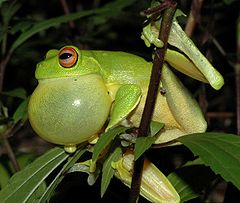
Vocal sac
Encyclopedia

Biological membrane
A biological membrane or biomembrane is an enclosing or separatingmembrane that acts as a selective barrier, within or around a cell. It consists of a lipid bilayer with embedded proteins that may constitute close to 50% of membrane content...
of skin possessed by most male frog
Frog
Frogs are amphibians in the order Anura , formerly referred to as Salientia . Most frogs are characterized by a short body, webbed digits , protruding eyes and the absence of a tail...
s. The purpose of the vocal sac is usually as an amplification of their mating or advertisement call. The presence or development of the vocal sac is one way of externally determining the sex of a frog in many species.
The vocal sac is open to the mouth cavity of the frog, with two slits on either side of the tongue. To call, the frog inflates its lungs. The air is then expelled from the lungs, through the larynx
Larynx
The larynx , commonly called the voice box, is an organ in the neck of amphibians, reptiles and mammals involved in breathing, sound production, and protecting the trachea against food aspiration. It manipulates pitch and volume...
, and into the vocal sac. The vibrations of the larynx emits a sound, which resonates
Resonance
In physics, resonance is the tendency of a system to oscillate at a greater amplitude at some frequencies than at others. These are known as the system's resonant frequencies...
within the vocal sac. The resonance causes the sound to be amplified, and allows the call to carry further. Muscles within the body wall force the air back and forth between the lungs and vocal sac. The frogs mouth and nose are kept shut for the duration of the call.
Development
The development of the vocal sac is different in most species, however they mostly follow the same line. The development of the unilobular vocal sac begins with two small growths on the floor of the mouth. They begin to grow, until they form two small pouches. The pouches expand until they meet in the centre of the mouth, and form one large cavity, which grows until it is fully developed.Purpose
The primary purpose of the vocal sac is to amplify the advertisement call of the male, and attract females from as large an area as possible. Species of frog without vocal sacs may only be heard within a radius of a few metres, whereas some species with vocal sacs can be heard over 1 km (0.621372736649807 mi) away. Modern frog species (NeobatrachiaNeobatrachia
Neobatrachia are a suborder of the Anura, the order of frogs and toads. This suborder is the most advanced and apomorphic of the three anuran orders alive today; hence its name, which literally means "new frogs"...
ns and some Mesobatrachia
Mesobatrachia
Mesobatrachia is the second largest of the Anura suborders of amphibians. It contains 6 families, 20 genera and 168 species. This is, of course, not matched to the 5,047 species noted in the Neobatrachia suborder...
ns) which lack vocal sacs tend to inhabit areas close to flowing water. The sound of the flowing water overpowers the advertisement call, so they must advertise by other means.
An alternative use of the vocal sac, is that employed by the frogs of the Rhinodermatidae
Rhinodermatidae
Rhinodermatidae are a family of small frogs found on the south-west coast of South America. There is only one genus , with just two species, of which the Chile Darwin's Frog is highly endangered or may already be extinct. The better known Darwin's Frog Rhinodermatidae are a family of small frogs...
family. The males of the two species of this family will scoop recently hatched tadpoles into their mouth, where they will move into the vocal sac. The tadpoles of Darwin's Frog
Darwin's Frog
Darwin's Frog is a frog native to the forest streams of Argentina and Chile. It was first described by French Zoologist André Marie Constant Duméril and his assistant Gabriel Bibron, and is named after Charles Darwin who discovered it in Chile during his world voyage on the HMS Beagle.The most...
(Rhinoderma darwinii) will remain in the vocal sac until metamorphisis, whereas the Chile Darwin's Frog
Chile Darwin's Frog
The Chile Darwin's Frog is one of only two members of the family Rhinodermatidae.It is endemic to Chile.This species of frog exhibits a highly unusual form of parental care in that the tadpoles spend part of their life developing in the vocal sac of their father, where they 'hitch a ride' to a...
(Rhinoderma rufum) will transport the tadpoles to a water source.

